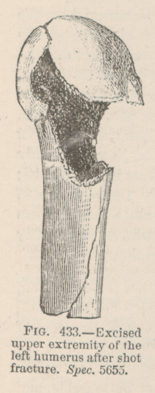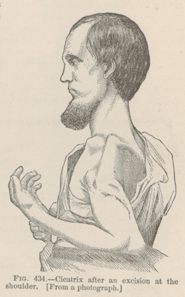Title: Baldock, L.
Source text: The Medical and Surgical History of the War of the Rebellion. (1861-65.), Part 2, Volume 2 (Washington, DC: Government Printing Office, 1876), 563.
Civil War Washington ID: med.d2e31192
TEI/XML: med.d2e31192.xml
CASE 1536.—Private L. Baldock, Co. A, 110th Ohio, aged 30 years, was wounded at Cold Harbor, June 3, 1864. Surgeon William M. Houston, 122d Ohio, reported that: "A conoidal musket ball passed through the left deltoid muscle and striking the humerus at its surgical neck, a little anterior to the centre, passing slightly upward through the head of the bone struck the bony wall of the chest, glanced downward, and was found lodged beneath the integuments, about half way down the side of the chest. The patient was immediately conveyed from the field to the hospital of the Third Division, Sixth Corps, and having been anæsthetized with chloroform, Surgeon W. M. Houston, 122d Ohio, assisted by Surgeon Robert Barr, 67th Pennsylvania, performed resection. A straight incision, about five inches long, was made, passing through the wound of entrance; the head of the humerus was disarticulated, and, by means of a chain saw, the shaft was sawn through at a point about four inches below the acromion process of the scapula, to which point the fractures extended. There was considerable blood lost, but no vessels were ligated. The patient reacted favorably. The wound was approximated with adhesive strips, and simple dressings were applied. On the succeeding day, he was conveyed in an ambulance wagon to White House Landing, and from thence to hospital in Washington, where he remained until August 17th, when he received a furlough for sixty days, and proceeded to his home, at Piqua, Ohio. At the expiration of his furlough, he went to Columbus, where be remained until March 7, 1865, when he was transferred to hospital at Camp Dennison. He was discharged April 14, 1865. The wound was entirely healed in eight months, reparation having been somewhat delayed in consequence of neglect and exposure after leaving hospital at Washington. At this date (November 30, 1869), Baldock enjoys good health, but complains, occasionally, of pain in the shoulder and elbow. The sawn end of the humerus is about three inches from the centre of the glenoid cavity. The movements of the forearm and hand are unimpaired. He can apply his fingers to the top of the corresponding shoulder, and by inclining his head can touch any part of his face or head. He can carry an ordinary pail full of water with the injured member, and finds it very useful in hoeing and other light work." Together with this report, Dr. Houston forwarded to the Museum the excised portion of the humerus, which is represented in the wood-cut (FIG. 433). On June 25, 1865, Examiner Samuel S. Gray, of Piqua, forwarded the photograph represented in the wood-cut (FIG. 434) to the Museum, and a second photograph, showing another aspect of the cicatrix. Both of these photographs are mounted with the specimen.

